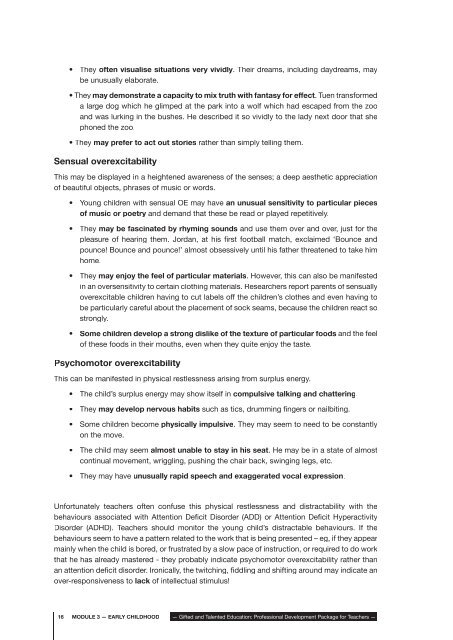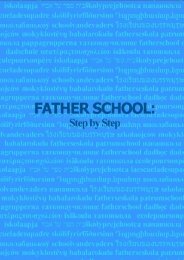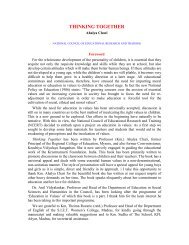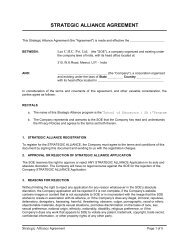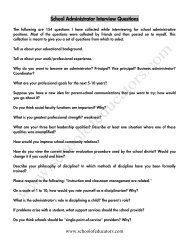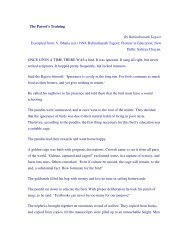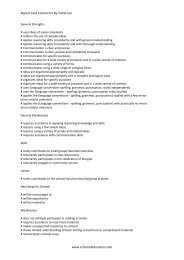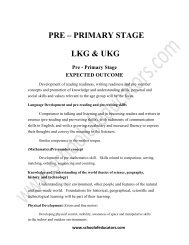Module 3 - School of Educators
Module 3 - School of Educators
Module 3 - School of Educators
- No tags were found...
Create successful ePaper yourself
Turn your PDF publications into a flip-book with our unique Google optimized e-Paper software.
• They <strong>of</strong>ten visualise situations very vividly. Their dreams, including daydreams, maybe unusually elaborate.• They may demonstrate a capacity to mix truth with fantasy for effect. Tuen transformeda large dog which he glimped at the park into a wolf which had escaped from the zooand was lurking in the bushes. He described it so vividly to the lady next door that shephoned the zoo.• They may prefer to act out stories rather than simply telling them.Sensual overexcitabilityThis may be displayed in a heightened awareness <strong>of</strong> the senses; a deep aesthetic appreciation<strong>of</strong> beautiful objects, phrases <strong>of</strong> music or words.• Young children with sensual OE may have an unusual sensitivity to particular pieces<strong>of</strong> music or poetryand demand that these be read or played repetitively.• They may be fascinated by rhyming sounds and use them over and over, just for thepleasure <strong>of</strong> hearing them. Jordan, at his first football match, exclaimed ‘Bounce andpounce! Bounce and pounce!’ almost obsessively until his father threatened to take himhome.• They may enjoy the feel <strong>of</strong> particular materials. However, this can also be manifestedin an oversensitivity to certain clothing materials. Researchers report parents <strong>of</strong> sensuallyoverexcitable children having to cut labels <strong>of</strong>f the children’s clothes and even having tobe particularly careful about the placement <strong>of</strong> sock seams, because the children react sostrongly.• Some children develop a strong dislike <strong>of</strong> the texture <strong>of</strong> particular foods and the feel<strong>of</strong> these foods in their mouths, even when they quite enjoy the taste.Psychomotor overexcitabilityThis can be manifested in physical restlessness arising from surplus energy.• The child’s surplus energy may show itself in compulsive talking and chattering.• They may develop nervous habits such as tics, drumming fingers or nailbiting.• Some children become physically impulsive. They may seem to need to be constantlyon the move.• The child may seem almost unable to stay in his seat. He may be in a state <strong>of</strong> almostcontinual movement, wriggling, pushing the chair back, swinging legs, etc.• They may have unusually rapid speech and exaggerated vocal expression.Unfortunately teachers <strong>of</strong>ten confuse this physical restlessness and distractability with thebehaviours associated with Attention Deficit Disorder (ADD) or Attention Deficit HyperactivityDisorder (ADHD). Teachers should monitor the young child’s distractable behaviours. If thebehaviours seem to have a pattern related to the work that is being presented – eg, if they appearmainly when the child is bored, or frustrated by a slow pace <strong>of</strong> instruction, or required to do workthat he has already mastered - they probably indicate psychomotor overexcitability rather thanan attention deficit disorder. Ironically, the twitching, fiddling and shifting around may indicate anover-responsiveness to lack<strong>of</strong> intellectual stimulus!16 MODULE 3 — EARLY CHILDHOOD— Gifted and Talented Education: Pr<strong>of</strong>essional Development Package for Teachers —


